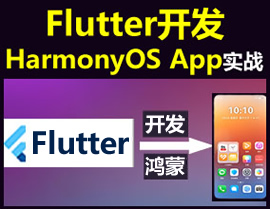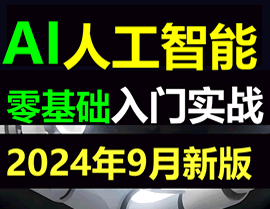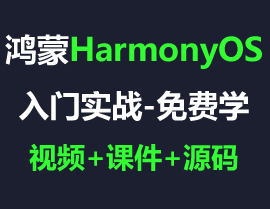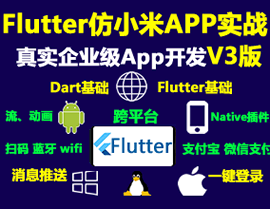HarmonyOS鸿蒙Next JS UI之Chart、Switch组件的组合使用
HarmonyOS鸿蒙Next JS UI之Chart、Switch组件的组合使用 HarmonyOS提供了常用的JS接口和组件,开发者可以根据实际场景和开发需求,选用不同的组件和接口。本节演示基础组件switch和chart组件的使用。
项目概述
在本教程中,我们将会通过一个简单的样例,将chart组件和switch组件进行结合,实现线形图、量规图、柱状图不同效果的展示,并通过switch切换chart组件数据的动静态显示。效果如下图所示,开发者还可以根据自己的需求添加不同的效果。
创建项目
创建一个JS UI的"Empty Ability(Js)" 模板项目。
项目名为“JsChartSwitch”
将组件添加到布局文件中
项目初始化之后,index.hml文件默认代码如下:
<div class="container">
<text class="title">{{ $t('strings.hello') }} {{ title }}</text>
</div>可以删除index.hml中的<text>组件默认代码,而后在container类中,添加如下switch、chart组件的代码。
定义switch组件
switch组件有动态和静态两种切换方式,添加如下switch组件代码。
<!-- switch组件代码 -->
<div class="switch-block">
<switch class="switch"
showtext="{{ showText }}"
texton="{{ textOn }}"
textoff="{{ textOff }}"
allow-scale="{{ allowScale }}"
onchange="change">
</switch>
</div>定义chart组件
添加chart组件呈现线形图、量规图、柱状图三种类型的图表,代码如下:
<!-- chart组件代码 -->
<div class="chart-block">
<text class="text-speed">利润</text>
<chart class="chart-data" type="line" ref="linechart" options="{{ lineOps }}" datasets="{{ lineData }}"></chart>
<text class="text-time">年份</text>
</div>
<div class="gauge-block">
<chart class="data-gauge" type="gauge" percent="{{ percent }}"></chart>
</div>
<div class="bar-block">
<text class="text-speed">销量</text>
<chart class="data-bar" type="bar" id="bar-chart" options="{{ barOps }}" datasets="{{ barData }}"></chart>
<text class="text-time">年份</text>
</div>设计样式
上面所有的组件,我们都定义了class属性,它对应的样式都定义在index.css中。我们删掉title类的默认样式代码后,在index.css中添加switch、chart组件的样式代码。
定义switch组件样式
这部分定义了switch-block容器的样式,以及switch组件的样式,代码如下:
.switch-block {
width: 98%;
height: 50px;
}
.switch {
text-padding: 10px;
font-size: 12px;
texton-color: #5F5F5F;
textoff-color: #707070;
}定义chart组件样式
这部分定义了chart组件线形图、量规图、柱状图三种类型的样式,在index.css中继续添加如下代码:
.chart-block, .gauge-block, .bar-block {
position: relative;
width: 98%;
border-radius: 5px;
background-color: #E3F8F9;
}
.text-speed {
position: absolute;
top: 10px;
left: 20px;
width: 10px;
font-size: 10px;
}
.chart-data {
margin: 10px 5px 10px;
width: 100%;
height: 100px;
}
.text-time {
position: absolute;
font-size: 10px;
bottom: 2px;
right: 10px;
}
.gauge-block, .bar-block {
margin-top: 10px;
}
.data-gauge {
width: 200%;
height: 200px;
margin: 10px 0 10px;
start-angle: 0;
total-angle: 360;
stroke-width: 20px;
colors: #CF0A2C, #8477DF, #17A98E;
weights: 3, 2, 1;
}
.data-bar {
width: 100%;
height: 200px;
margin: 10px 5px 10px;
}为组件添加响应事件
前面布局中的组件已经定义了初始值,接下来要补充更多的数据,在index.js中首先添加如下代码:
export default {
data: {
interval: null,
showText: true,
textOn: '动态',
textOff: '静态',
allowScale: true,
dataLength: 5,
barGroup: 3,
lineData: null,
lineOps: {
xAxis: {
min: 0,
max: 5,
display: true
},
yAxis: {
min: 0,
max: 100,
display: true
},
series: {
lineStyle: {
width: '1px',
smooth: true
},
headPoint: {
shape: 'circle',
size: 10,
strokeWidth: 2,
fillColor: '#ffffff',
strokeColor: '#8477DF',
display: true
},
loop: {
margin: 2
}
}
},
percent: 100,
barData: [
{
fillColor: '#CF0A2C',
data: [2, 20, 99, 56, 23]
},
{
fillColor: '#8477DF',
data: [99, 88, 2, 67, 12]
},
{
fillColor: '#17A98E',
data: [56, 2, 77, 99, 78]
}
],
barOps: {
xAxis: {
min: 0,
max: 20,
display: true,
axisTick: 5
},
yAxis: {
min: 0,
max: 100,
display: true
}
}
},
// 初始化
onInit() {
this.changeLine();
},
change(e) {
if (e.checked) {
this.interval = setInterval(() => {
this.changeLine(); // 更新线形图数据
this.changeGauge(); // 更新量规图数据
this.changeBar(); // 更新柱状图数据
}, 1000);
} else {
clearInterval(this.interval);
}
},
// 更新线形图数据
changeLine() {
var dataArray = [];
for (var i = 0; i < this.dataLength; i++) {
var nowValue = Math.floor(Math.random() * 99 + 1);
var obj = {
"value": nowValue,
"description": nowValue + "",
"textLocation": "top",
"textColor": "#CDCACA",
"pointStyle": {
"shape": "circle",
"size": 5,
"fillColor": "#CF0A2C",
"strokeColor": "#CF0A2C"
}
};
dataArray.push(obj);
}
this.lineData = [{
strokeColor: '#17A98E',
data: dataArray,
gradient: false
}];
},
// 更新量规图数据
changeGauge() {
this.percent = parseInt(this.percent) >= 99 ? 0 : parseInt(this.percent) + 1;
},
// 更新柱状图数据
changeBar() {
for (var i = 0; i < this.barGroup; i++) {
var dataArray = this.barData[i].data;
for (var j = 0; j < this.dataLength; j++) {
dataArray[j] = Math.floor(Math.random() * 99 + 1);
}
}
this.barData = this.barData.splice(0, this.barGroup + 1);
}
}这些值的具体含义,可以参考如下表格:
运行
运行应用,可以看到初始化界面如下:
点击上面的switch组件,可以看到chart数据发生了变化,界面如下:
源码
上述示例源码,可以在https://github.com/waylau/harmonyos-tutorial仓库找到。
你好,想问下switch组件的静态和动态方式怎么说,可以给举个小例子解释一下吗?
更多关于HarmonyOS鸿蒙Next JS UI之Chart、Switch组件的组合使用的实战系列教程也可以访问 https://www.itying.com/category-93-b0.html
折线图里面里面的append更新数据时怎么设置从最右端动态刷新然后历史数据左移擦除啊,按文档使用后的效果总是重新开始动态更新,这样不是很符合展示需要,请指点一下,谢谢
总的来说,HarmonyOS是一款非常优秀的操作系统,期待它能在未来带给我们更多惊喜!
不能设置x轴的数据吗
总的来说,HarmonyOS是一款非常优秀的操作系统,期待它能在未来带给我们更多惊喜!
能呀。~多谢支持,可以从我的主页找到我后续更新的内容~
关注我不迷路
又发我看不懂的帖子……把我昵称送给你
多谢支持,可以持续关注后续更新
哈哈哈哈,看懂了差不多一半,我在修炼一下吧。
多谢支持,可以持续关注后续更新
“一个简单的样例”,我菜死了
多些支持,期待我的后续更新
在HarmonyOS鸿蒙Next JS UI中,Chart和Switch组件的组合使用可以实现动态图表切换功能。Switch组件用于控制图表的显示模式或数据源切换,当用户操作Switch时,通过监听其状态变化事件,动态更新Chart组件的数据或样式。例如,可以使用Switch切换不同的图表类型(如柱状图、折线图),或展示不同的数据集。通过合理布局和事件绑定,Chart和Switch的组合能够提供灵活且响应式的数据可视化体验。







